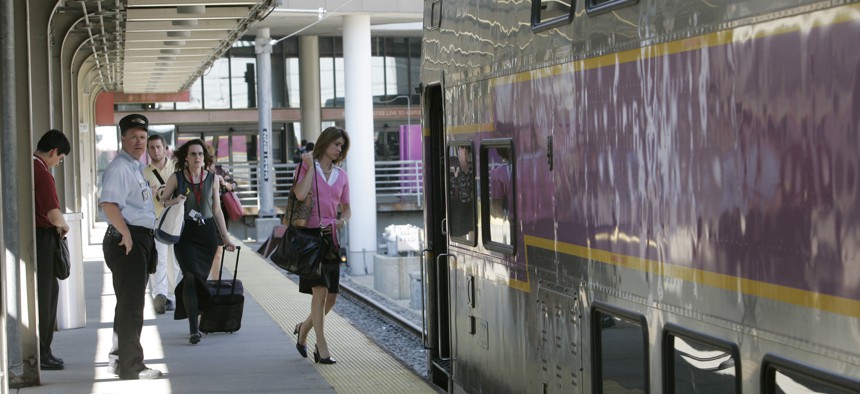The Case for Going Big With Infrastructure Spending

Commuters rush to board the 4:35 p.m. train out of South Station in Boston during the early part of rush hour. The train travels to points south, terminating in Providence, R.I. John Bohn/The Boston Globe via Getty Images
One mayor sees a “once-in-a-lifetime opportunity” with the wave of public works dollars, but he’s also concerned ambitious projects could get passed over.
If Mayor Jorge Elorza had his way, the influx of infrastructure money coming from the federal government would lead to big changes, like speeding up commuter rail trips between Boston and his hometown of Providence, Rhode Island.
But he is afraid that state and local leaders will shy away from such ambitious goals and opt for simpler ideas that are already on the drawing board instead.
It’s a common quandary for state and local officials as they determine how to spend their share of the $1.2 trillion federal infrastructure law: invest in a handful of big ideas, or finally move ahead with run-of-the-mill, but long-stalled projects.
State and local officials have an unusual amount of money to dole out, not just because of the infrastructure law, but also because of federal pandemic aid and because of robust tax collections over the last year.
“What we feel here is the pressure really to just spread it like peanut butter,” said Lauren Larson, Colorado’s budget director, during a Thursday briefing with Elorza hosted by the Volcker Alliance, a nonprofit group that promotes responsible government spending.
In Colorado, though, state leaders decided to save half of the one-time money filling state coffers. The half that they are spending is focused on making housing affordable, providing behavioral health services and developing the state’s workforce, Larson said.
In Rhode Island, Elorza said the plan seems to be to use one-time infrastructure money from the federal government to improve roads and bridges that are already included in the state’s capital plan.
But while the federal spending is substantial, it is not enough to meet all of the needs at the local level. And this is why Elorza argues the money should be targeted towards projects that support key priorities.
“I think it’s universally understood, at least here in Rhode Island, that creating a tighter link to Boston would be strategically smart to do,” Elorza said. Interstate 95, which connects the two, is already packed, he noted.
Now would be a good time for Rhode Island and Massachusetts officials to improve the rail route between their state capital cities, he said.
“This once-in-a-lifetime opportunity, the sheer scale of these infrastructure dollars… is one that we should really take advantage of,” Elorza said. “But at the same time, the state has a number of significant needs [that are] the low-hanging fruit.”
Public works projects that have already been lined up and have been awaiting funding would also likely generate little public outcry, and they could put people to work right away.
“All of the incentives seem to steer us in the direction of doing the easy thing, not the transformational thing,” he said.
Improving the commuter rail link would require considerable effort, Elorza acknowledged.
The biggest challenge might be to convince people in Massachusetts to make the project a priority. Cutting down the commute time from an hour to 45 minutes would require track upgrades in Massachusetts, and some of the Massachusetts communities along the route would be skipped by express trains, the mayor said.
“There are some politics to it. There are some regional issues,” he said. “But frankly, this is one of those areas where additional resources paper over a lot of those conflicts and challenges, they help you overcome them.”
In Colorado, Larson said, officials found common ground by funding a program to revitalize Main Streets. Urban areas used the money to improve public transit, while rural communities focused on bringing visitors back to downtowns. But local communities have to spend the money quickly.
“That has been a really successful program that has bridged the divide,” Larson said.
Daniel C. Vock is a senior reporter for Route Fifty based in Washington, D.C.
NEXT STORY: How 5G can transform public safety






